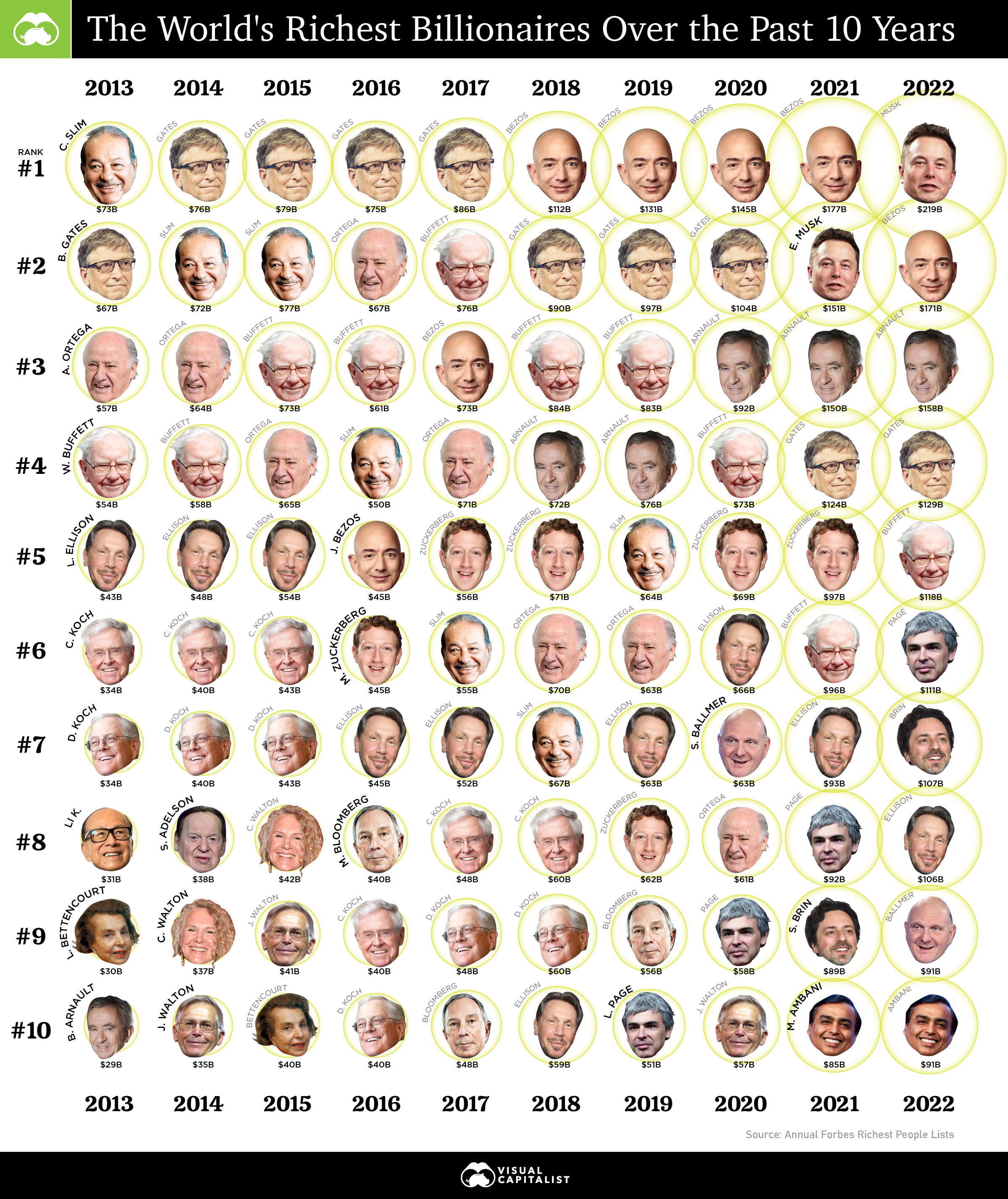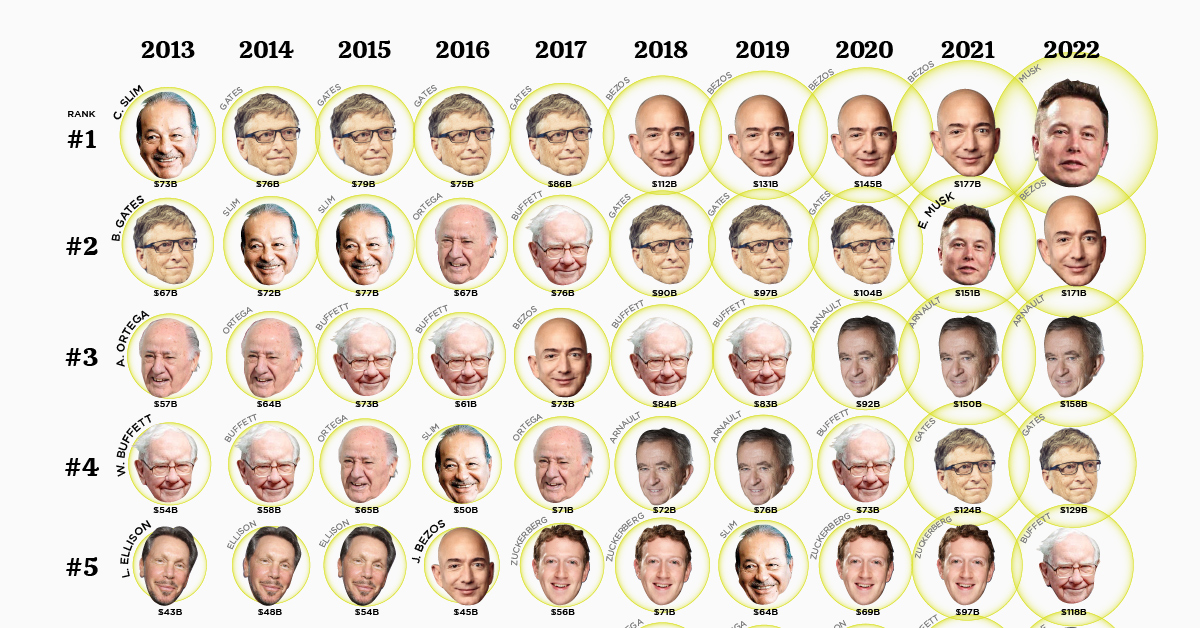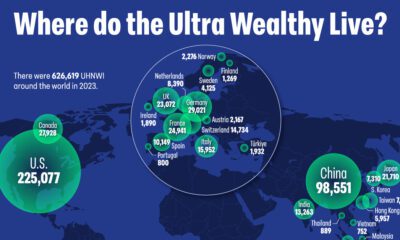Money
Ranked: The World’s Richest Billionaires Over the Past 10 Years

Ranked: The World’s Richest Billionaires Over the Past 10 Years
The last decade has seen a number of changes in the world’s richest billionaires list.
For one, there are new faces at the top of the leaderboard that were never there before. One of the most obvious changes though, is that the richest billionaires have accumulated a lot more wealth in recent years.
Using annual data from Forbes on the richest billionaires, we’ve visualized the wealth and ranking of the top 10 billionaires over the past decade.
Who are the World’s Richest Billionaires?
While the pecking order has fluctuated, the leaderboard remains very exclusive. Out of a possible 10 spots, there are only 19 individuals that have made the list over the last decade.
Here’s the current list of richest billionaires in 2022, including when they first made the list (if in the last decade):
| Rank | Name | Country | Net Worth (2022) | First Year on List* |
|---|---|---|---|---|
| #1 | Elon Musk | 🇺🇸 U.S. | $219 billion | 2021 |
| #2 | Jeff Bezos | 🇺🇸 U.S. | $171 billion | 2016 |
| #3 | Bernard Arnault | 🇫🇷 France | $158 billion | - |
| #4 | Bill Gates | 🇺🇸 U.S. | $129 billion | - |
| #5 | Warren Buffett | 🇺🇸 U.S. | $118 billion | - |
| #6 | Larry Page | 🇺🇸 U.S. | $111 billion | 2019 |
| #7 | Sergey Brin | 🇺🇸 U.S. | $107 billion | 2021 |
| #8 | Larry Ellison | 🇺🇸 U.S. | $106 billion | - |
| #9 | Steve Ballmer | 🇺🇸 U.S. | $91 billion | 2020 |
| #10 | Mukesh Ambani | 🇮🇳 India | $91 billion | - |
*Billionaires with “-” first made the list at an earlier date. Example: Mukesh Ambani made the 2008 list.
Microsoft co-founder turned philanthropist, Bill Gates, is a perennial presence at the top of these lists. Gates is currently at his lowest rank over this time period, but is still in fourth spot. The billionaire has pledged to give away nearly all of his fortune to the eponymously named Bill & Melinda Gates Foundation.
From 2018 to 2021, Jeff Bezos sat at the top of the world’s richest people ranking, only to be bumped out by Elon Musk. In 2020, Bezos became the first person to amass a $200 billion fortune after Amazon’s stock price surged during the pandemic. In recent months, Bezos’ net worth has taken a hit as Amazon’s share price has fallen back down to Earth.
Today, Elon Musk is the world’s richest person.
The Rich Get Richer
Over time, the median net worth of the richest billionaires has grown significantly.
| Year | Median Net Worth of Top 10 Billionaires |
|---|---|
| 2013 | $39 billion |
| 2014 | $44 billion |
| 2015 | $49 billion |
| 2016 | $45 billion |
| 2017 | $56 billion |
| 2018 | $71 billion |
| 2019 | $64 billion |
| 2020 | $68 billion |
| 2021 | $97 billion |
| 2022 | $115 billion |
Most fortunes are held in the form of business equity, real estate, and publicly-traded stocks—all asset classes that have benefited from the era of cheap money and ultra-low interest rates.
Over the decade period, the median net worth of the top 10 billionaires has nearly tripled from $39 billion to $115 billion.
In fact, the first billionaire to pass the $100 billion threshold was Jeff Bezos in 2018, when he took the top spot on the list from Bill Gates. However, now all but two on the top 10 wealthiest list are centibillionaires.
Money
How Debt-to-GDP Ratios Have Changed Since 2000
See how much the debt-to-GDP ratios of advanced economies have grown (or shrank) since the year 2000.

How Debt-to-GDP Ratios Have Changed Since 2000
This was originally posted on our Voronoi app. Download the app for free on Apple or Android and discover incredible data-driven charts from a variety of trusted sources.
Government debt levels have grown in most parts of the world since the 2008 financial crisis, and even more so after the COVID-19 pandemic.
To gain perspective on this long-term trend, we’ve visualized the debt-to-GDP ratios of advanced economies, as of 2000 and 2024 (estimated). All figures were sourced from the IMF’s World Economic Outlook.
Data and Highlights
The data we used to create this graphic is listed in the table below. “Government gross debt” consists of all liabilities that require payment(s) of interest and/or principal in the future.
| Country | 2000 (%) | 2024 (%) | Change (pp) |
|---|---|---|---|
| 🇯🇵 Japan | 135.6 | 251.9 | +116.3 |
| 🇸🇬 Singapore | 82.3 | 168.3 | +86.0 |
| 🇺🇸 United States | 55.6 | 126.9 | +71.3 |
| 🇬🇧 United Kingdom | 36.6 | 105.9 | +69.3 |
| 🇬🇷 Greece | 104.9 | 160.2 | +55.3 |
| 🇫🇷 France | 58.9 | 110.5 | +51.6 |
| 🇵🇹 Portugal | 54.2 | 104.0 | +49.8 |
| 🇪🇸 Spain | 57.8 | 104.7 | +46.9 |
| 🇸🇮 Slovenia | 25.9 | 66.5 | +40.6 |
| 🇫🇮 Finland | 42.4 | 76.5 | +34.1 |
| 🇭🇷 Croatia | 35.4 | 61.8 | +26.4 |
| 🇨🇦 Canada | 80.4 | 103.3 | +22.9 |
| 🇨🇾 Cyprus | 56.0 | 70.9 | +14.9 |
| 🇦🇹 Austria | 65.7 | 74.0 | +8.3 |
| 🇸🇰 Slovak Republic | 50.5 | 56.5 | +6.0 |
| 🇩🇪 Germany | 59.3 | 64.0 | +4.7 |
| 🇧🇪 Belgium | 109.6 | 106.8 | -2.8 |
| 🇮🇱 Israel | 77.4 | 56.8 | -20.6 |
| 🇮🇸 Iceland | 75.8 | 54.6 | -21.2 |
The debt-to-GDP ratio indicates how much a country owes compared to the size of its economy, reflecting its ability to manage and repay debts. Percentage point (pp) changes shown above indicate the increase or decrease of these ratios.
Countries with the Biggest Increases
Japan (+116 pp), Singapore (+86 pp), and the U.S. (+71 pp) have grown their debt as a percentage of GDP the most since the year 2000.
All three of these countries have stable, well-developed economies, so it’s unlikely that any of them will default on their growing debts. With that said, higher government debt leads to increased interest payments, which in turn can diminish available funds for future government budgets.
This is a rising issue in the U.S., where annual interest payments on the national debt have surpassed $1 trillion for the first time ever.
Only 3 Countries Saw Declines
Among this list of advanced economies, Belgium (-2.8 pp), Iceland (-21.2 pp), and Israel (-20.6 pp) were the only countries that decreased their debt-to-GDP ratio since the year 2000.
According to Fitch Ratings, Iceland’s debt ratio has decreased due to strong GDP growth and the use of its cash deposits to pay down upcoming maturities.
See More Debt Graphics from Visual Capitalist
Curious to see which countries have the most government debt in dollars? Check out this graphic that breaks down $97 trillion in debt as of 2023.
-

 Real Estate2 weeks ago
Real Estate2 weeks agoVisualizing America’s Shortage of Affordable Homes
-

 Technology1 week ago
Technology1 week agoRanked: Semiconductor Companies by Industry Revenue Share
-

 Money1 week ago
Money1 week agoWhich States Have the Highest Minimum Wage in America?
-

 Real Estate1 week ago
Real Estate1 week agoRanked: The Most Valuable Housing Markets in America
-

 Business2 weeks ago
Business2 weeks agoCharted: Big Four Market Share by S&P 500 Audits
-

 AI2 weeks ago
AI2 weeks agoThe Stock Performance of U.S. Chipmakers So Far in 2024
-

 Misc2 weeks ago
Misc2 weeks agoAlmost Every EV Stock is Down After Q1 2024
-

 Money2 weeks ago
Money2 weeks agoWhere Does One U.S. Tax Dollar Go?


















